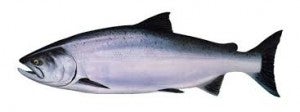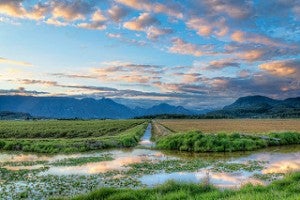
California’s Chinook salmon are large fish that can grow up to 58 inches in length and weigh up to 129 pounds. But most salmon do not grow this large, especially in drought conditions, lacking sufficient habitat. (Credit: seafoodwatch.org)
Already an endangered species, California salmon populations have reached record lows.
Fisheries officials with the National Oceanic and Atmospheric Administration found that just 3 percent of this generation of winter-run Chinook salmon survived in the Sacramento River. This is a record low survival rate – more than 10 times worse than the survival rate before the California drought.
How does drought affect salmon?
Salmon at any stage need cold water to survive, and severe drought conditions have put a chokehold on the state’s water supply, which relies on snow melt from the Sierra Nevada Mountains. Without this snow melt, there is less cold water flowing into California’s waterways, creating higher than normal water temperatures in the Sacramento River.
But it’s not just the lack of cold water that’s affecting salmon populations. They also lack sufficient habitat to grow and thrive. Even if the drought ended today, they would still be in peril without adequate habitat.
Floodplain habitats provide the best growth conditions for juvenile Chinook salmon, and larger salmon have a higher chance of surviving, spawning and ultimately boosting the population. California has the opportunity to create more of this critical habitat on private lands to improve conditions for the fish, and for agricultural lands.
Creating floodplains helps fish and farms

Credit: Waterways via photopin (license)
There are two types of salmon habitat that farmers can provide to help fish population.
One option is for rice growers in close proximity to the river system to keep their fields flooded and available to juvenile salmon during the winter. This perfect pairing of rice and salmon was dubbed the “Nigiri Project” in an agricultural floodplain habitat experiment on Knaggs Ranch – a working farm outside of Sacramento.
To create more natural habitat, farmers near the Sacramento River can reconnect the floodplain and allow natural flooding of low lying agriculture land to provide habitat for salmon and improve groundwater recharge. This practice has the added benefit of helping to alleviate the effects of drought.
A pioneering program under development in California’s Central Valley is offering incentives to help farmers adopt these practices.
The Central Valley Habitat Exchange uses advanced habitat accounting tools to measure the quality of salmon habitat to better target restoration dollars so that private landowners can be paid for restoring salmon habitat. But the exchange isn’t limited to salmon – it also rewards landowners for improving habitat for other at-risk wildlife, like Swainson’s hawk.
Good signs from the field
Field testing has been conducted on Knaggs Ranch, home of the “Nigiri Project” I mentioned above. John Brennan is the farm manager for Knaggs Ranch, where he has collaborated with California Trout and others to help keep water in the field to support salmon nurseries and to also provide beneficial habitat for water fowl and shore birds.
By adjusting land management on the farm to benefit species, John is generating conservation outcomes that he hopes can be sold to private and public investors through the Central Valley Habitat Exchange in the future. Potential investors include state agencies seeking credits to meet restoration goals.
The Central Valley Habitat Exchange will help ensure that, when water is available, the conditions for success and species recovery are in place, reducing risk for landowners and threats to wildlife. With more opportunities like this to help fish and farmers, we can help California’s food system, environment and economy weather the drought.










